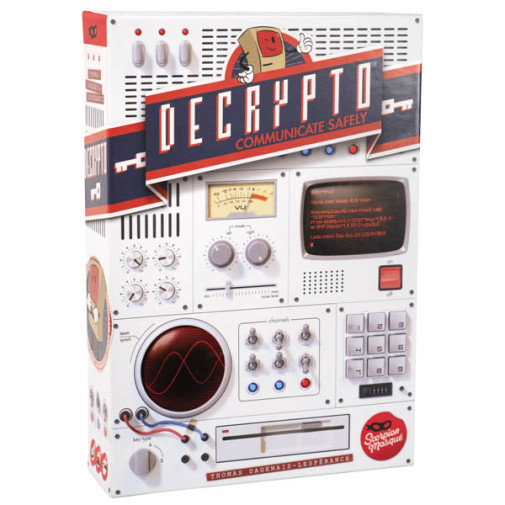We use cookies to make your experience better. To comply with the new e-Privacy directive, we need to ask for your consent to set the cookies. Learn more.
Decrypto Game
Two opposing teams of spies enter this code-cracking arena. Only one emerges victorious! In this veritable verbal volley, each team sits opposite their 4 privy "code words." These 4 words match to numbers 1-4. To begin a round, each Encrypter (one per team) draws a card with a 3-character sequence, such as "4-1-2." Suppose White Team has these words in order 1-4: "Bottle," "Camera," "Egg," and "Tape." The White Encrypter may think of and announces the following clues: "Sticky," "Glass," and "Picture." Other players on the team then guess the intended sequence. If the revealed sequence matches the team's guess, no penalty is given - but if the guess is wrong, the team gets a miscommunication token! Two tokens and a team loses.
Meanwhile, Black Team makes a note of the clues and sequence; in this way, both teams keep a running tally of their own and their opponent's clues. In future rounds, this becomes important as each team gets the first chance to "intercept" the other team's sequence! Successfully intercepting two messages earns that team a win. Compared to Codenames, this provides an interesting twist on word-guessing: Encrypters must make their clues obvious enough for their own team to guess, but vague enough to prevent the opposing team from intercepting the sequence! Encrypters can also use phrases or other "passcodes" (within the realm of reason) to further obscure intent. Overall, a fantastic party game for any synonym sleuth! For 3-8 players; 15-45-minute playtime.
Players compete in two teams in Decrypto, with each trying to correctly interpret the coded messages presented to them by their teammates while cracking the codes they intercept from the opposing team.
In more detail, each team has their own screen, and in this screen they tuck four cards in pockets numbered 1-4, letting everyone on the same team see the words on these cards while hiding them from the opposing team. In the first round, each team does the following: One team member takes a code card that shows three of the digits 1-4 in some order, e.g. 4-2-1. They then give a coded message that their teammates must use to guess this code. For example, if the team's four words are "pig", "candy", "tent", and "son", then you might say "child-mouth-tail" and hope that your teammates can correctly map those words to 4-2-1. If they guess correctly, great; if not, you receive a black mark of failure.
Starting in the second round, a member of each team must again give a clue about their words to match a numbered code. If you get 2-4-3, you might now say, "sucker-finger-grass". The other team then attempts to guess our numbered code. If they're correct, they receive a white mark of success; if not, then your team must guess the number correctly or take a black mark of failure. (Guessing correctly does nothing except avoid failure and give the opposing team information about what our hidden words might be.)
The rounds continue until a team collects either its second white mark (winning the game) or its second black mark (losing the game). Games typically last between 4-7 rounds.
- Players: 3-8
- Ages: 12+
- Play Time: 30 min
- Category: Party game
| Product Format: | Other |
|---|---|
| Brand: | Scorpion Masque |
| Grades: | 7-AD |
| EAN/UPC: | 807658000723 |
| Length in Inches: | 9 |
| Width in Inches: | 6.25 |
| Height in Inches: | 2.125 |
| Weight in Pounds: | 1.15 |

